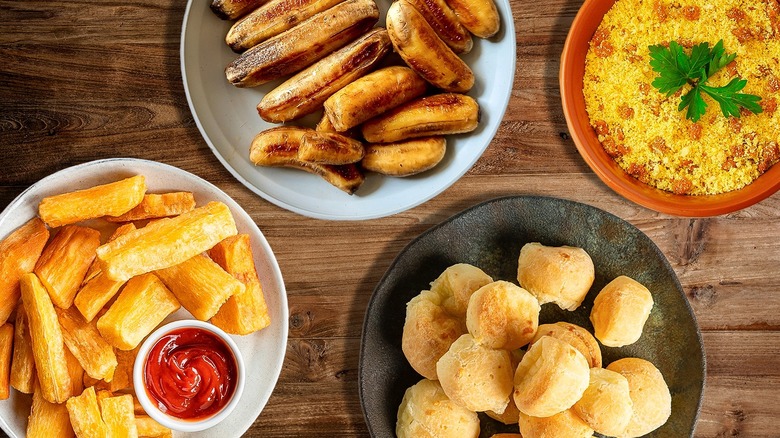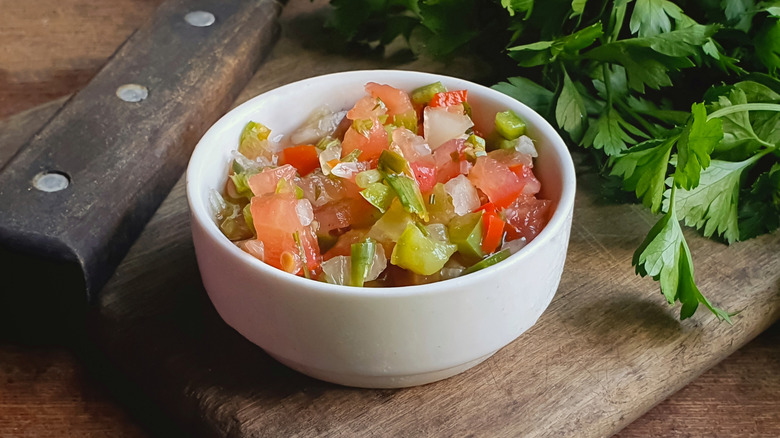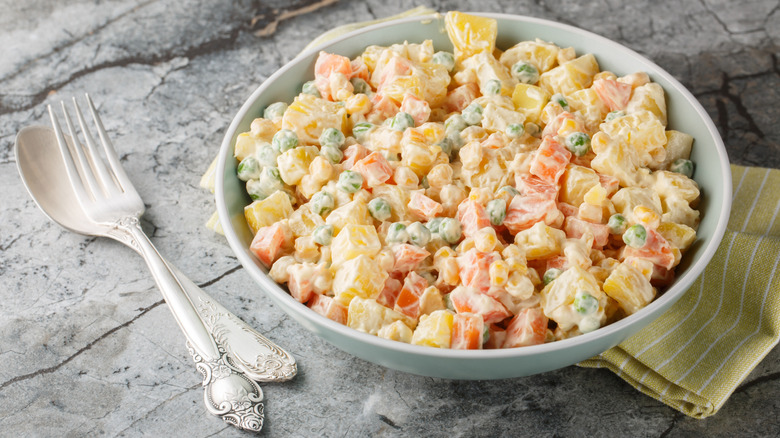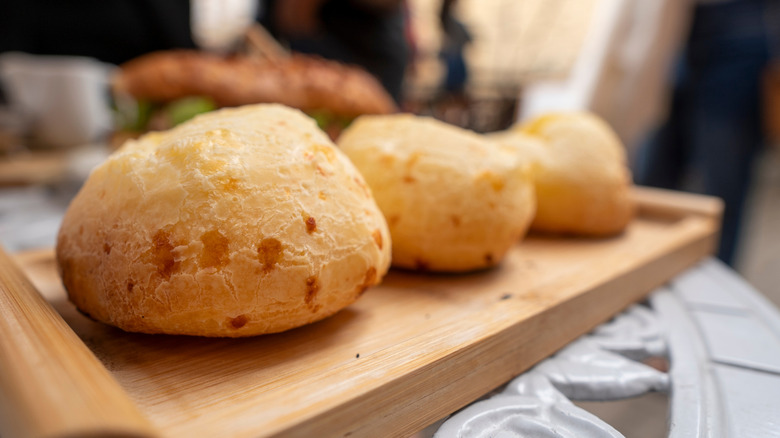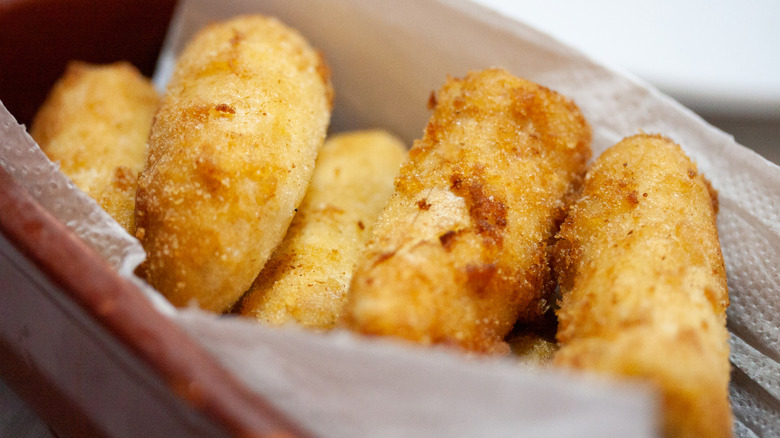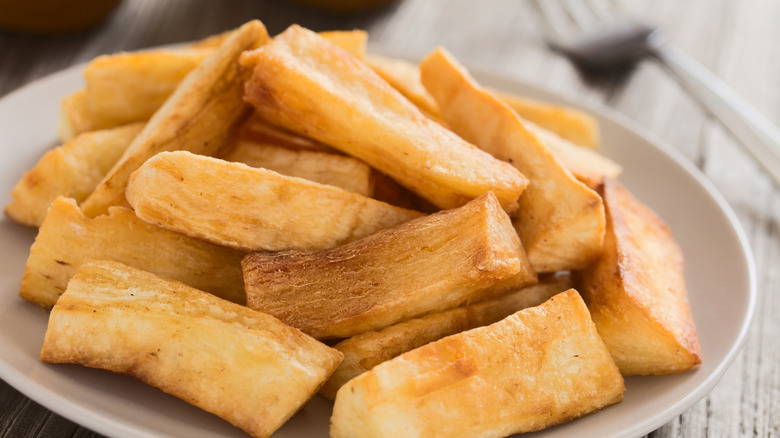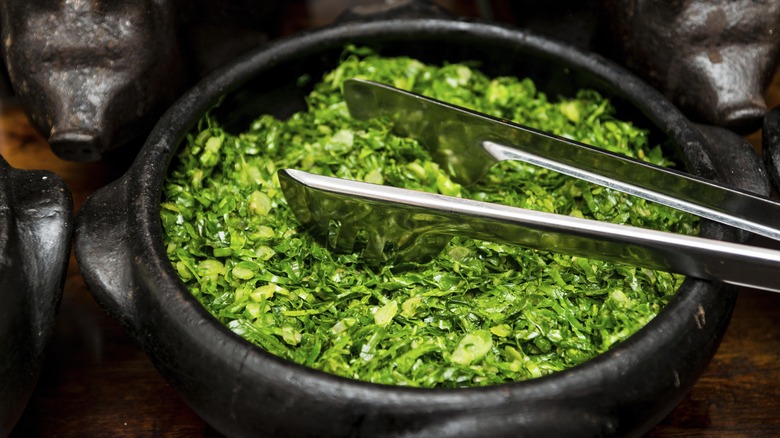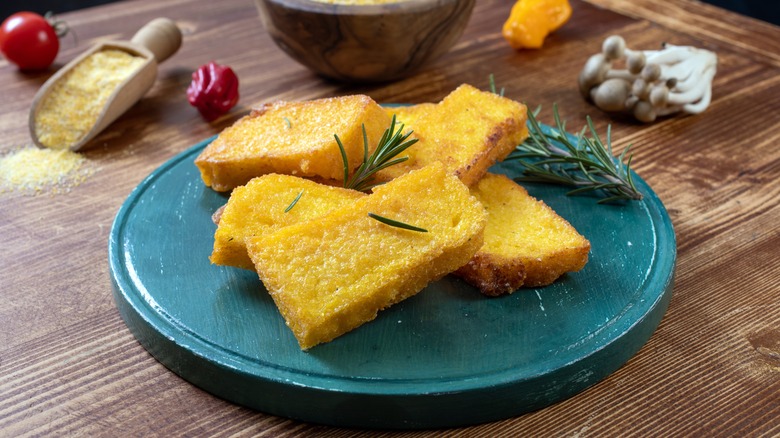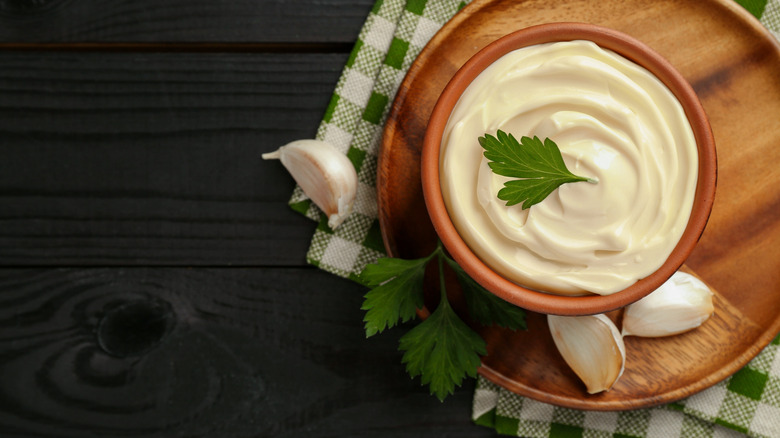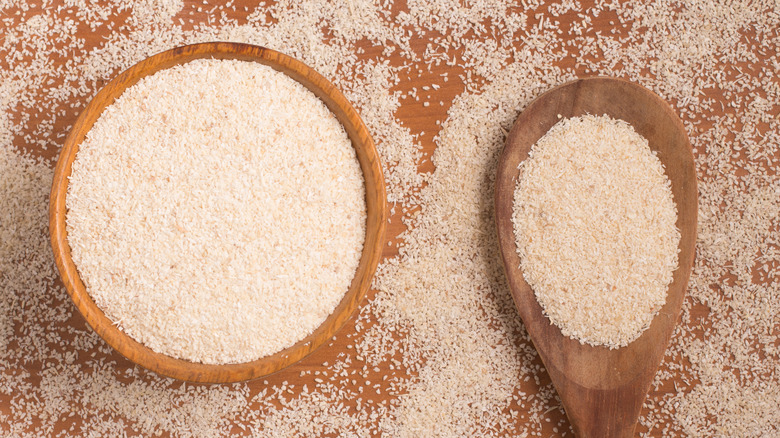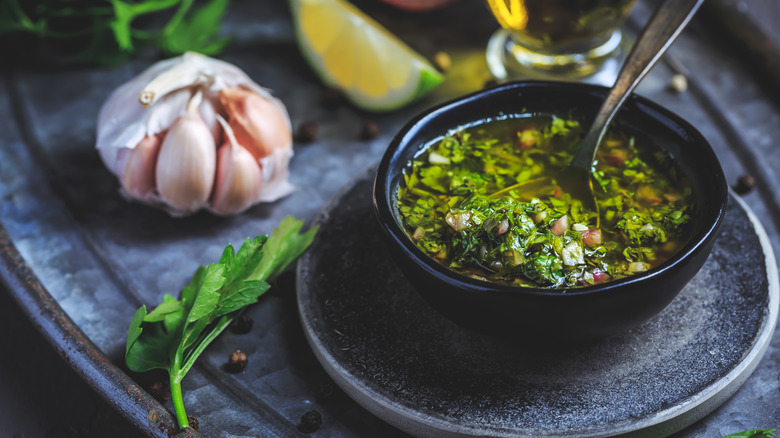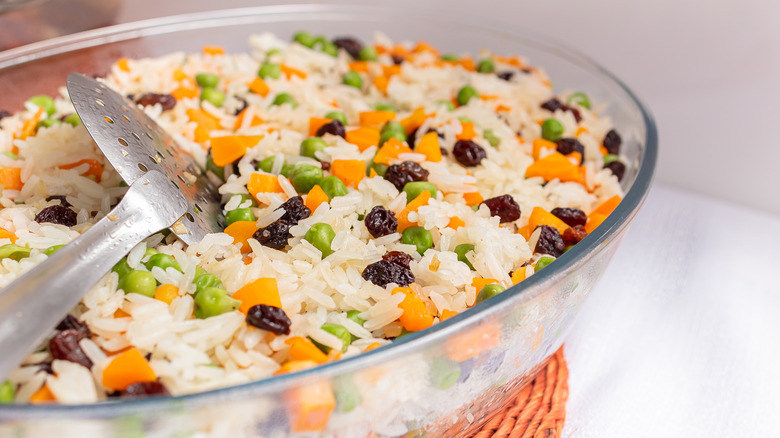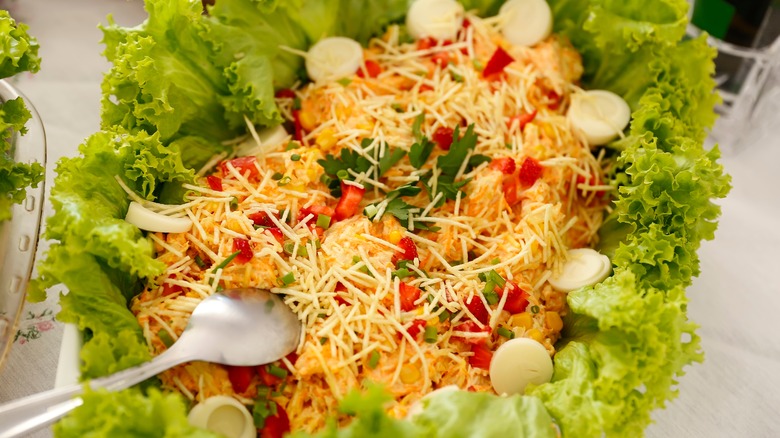A Guide To All The Sides At A Brazilian Steakhouse
Walking into a Brazilian steakhouse is like stepping into a carnivorous fantasy. Skewers of sizzling beef, lamb, pork, and chicken parade from grill to table, sliced straight onto your plate until you're ready to tap out. The meat steals the show, and rightfully so, but ask anyone who knows their way around a churrascaria and they'll tell you the real secret lives on the sidelines.
The buffet and side plates aren't just filler — they're the glue that makes the whole feast work. Without something starchy to soak up juices or fresh to cut through fat, you'd never make it past the first few skewers. Brazilians know this, which is why steakhouses often boast spreads loaded with an array of palate cleansers and flavor boosters designed to turn a pile of grilled meat into a balanced (if still over-the-top) meal.
I lived in southern Brazil, where churrasco originated, for two years, and learned quickly that these sides are as much about culture as cuisine. Each one tells its own story, and together, they keep the meal moving, lending the meal a sort of rhythm. So, don't make the rookie mistake of missing the sides at a Brazilian steakhouse.
Farofa
Farofa is one of those side dishes that make a trip to a Brazilian steakhouse truly unique. Who would've thought that toasted cassava flour would have a place in a steakhouse? But this side is crucial to the Brazilian culinary experience. Think of farofa as the crunchy counterweight to all that tender, juicy meat. Traditionally, the flour is toasted in butter until golden, which gives it a nutty, roasted flavor.
I add thyme and toasted cashews to my own farofa, but every kitchen has its own take. Smoky bacon crumbles, scrambled eggs, caramelized onions, and herbs are among the most common additions. The result is a dry-looking topping that doesn't look like much until you spoon it over beans and rice or drag your steak through it. Farofa absorbs the drippings, catches the flavors, and gives your bite a crunch that makes the meat taste even meatier.
Brazilian steakhouses often treat farofa as a necessary sidekick to rice and beans (think croutons with a salad or crackers with soup). Passing on the farofa would be like ignoring the salsa at a taqueria, and doing so is one of the biggest mistakes people make when dining at Fogo de Chão and other Brazilian steakhouses.
Rice and beans
Rice and beans are another Brazilian staple, popping up everywhere from weekday lunches to Sunday family spreads. At a steakhouse, it might not dazzle with flashy presentation, but don't make the mistake of skipping it. This is the foundation that keeps the churrasco feast balanced.
The rice is usually plain and fluffy white grains steamed until they're tender but not sticky. It's intentionally simple because its job is to soak up the juices from grilled meats and provide a canvas for everything else. The beans are typically black (though sometimes brown or pinto, depending on the region), stewed slowly with garlic, onions, and maybe a bay leaf or a bit of pork for depth.
Arroz e feijão (that's Portuguese for rice and beans) aren't just filler. After a salty, fatty bite of picanha or lamb, a forkful of rice and beans brings you back to center, so you're ready for the next round of skewers.
Vinagrete
It's no secret that churrasco is a meaty affair, and when you need some freshness and acidity to cut through the heaviness, vinagrete is there for you. It may look like salsa, and it's tempting to make the comparison, but it's something entirely different. Vinagrete is a refreshing mix of tomatoes, onions, parsley, and sometimes green bell pepper, all finely chopped and dressed in vinegar and olive oil.
At the steakhouse buffet, you'll usually find it in a big chilled bowl, and the move is to spoon it generously alongside your rice, beans, and farofa. The acidity transforms the mildness of the arroz e feijão into something that feels vibrant and layered, like adding pickled onions to a sandwich. It's also a perfect counterpoint to fatty cuts of beef or pork, and if you pair your meat with vinagrete, you somehow feel lighter, like you could keep going back for more.
Vinagrete is a humble side dish and you don't need too much of it, but it's one of the most important elements of the churrasco experience. Without its crunchy freshness, Brazilian barbecue can feel like it tips too far into excess.
Salada de maionese
Brazil's version of potato salad, salada de maionese, translates literally to mayonnaise salad, which might sound a little intense to an American at a Brazilian steakhouse. Don't expect the mustardy tang of a classic Labor Day potato salad you might find Stateside. This is a creamier, gentler affair, and while it's often delicious, I advise you to go easy because it's a filling side dish that might take up valuable room that you might save for meatier mains.
At its core, salada de maionese is boiled potatoes mixed with plenty of mayo until everything is luxuriously coated. Carrots and a green veggie like peas or green beans are almost always present, and sometimes even apples or raisins sneak in for sweetness, while chopped parsley or green onions add a fresh pop. I've had versions with hard-boiled eggs or shredded chicken folded in, making it feel like a meal hiding inside a side dish.
At the steakhouse, it works as a cooling element against all the sizzling meat. The richness of the mayo calms the spice of a chili sauce, the potatoes cushion the saltiness of pork, and the pops of vegetable sweetness make you feel (just barely) virtuous.
Pão de queijo
One of the biggest challenges at a Brazilian steakhouse is trying not to fill up on pão de queijo. These little golden domes are tiny, puffy rolls made with tapioca flour instead of wheat, which means they're naturally gluten-free and have that uniquely chewy, stretchy interior. They typically arrive warm and chewy, and if you can stop after eating only one, more power to you.
They're flavored with salty, melty cheese (usually Parmesan, but any hard, salty cheese will do) blended right into the dough so every bite is equal parts bread and cheese. The outside bakes up with a delicate crust, while the inside stays airy and chewy, somewhere between a roll and a mochi.
At the churrascaria, these little breads often land on your table before the skewers even arrive, like a pre-game snack. Pão de queijo isn't just a side; it's a cultural icon. In Brazil, you'll often find them at cafés, bakeries, and even gas stations. It's also consistently ranked as one of the best items on the Fogo de Chão menu according to customer reviews.
Banana frita
When the parade of meats starts to overwhelm with salt and savoriness, banana frita is the sweet relief you didn't know you needed. This classic Brazilian side (known as banana à milanesa when covered in breadcrumbs) takes bananas and lightly fries them until the edges caramelize and the sweetness shines.
Banana frita works a little like cranberry sauce at Thanksgiving, cutting through the heaviness with some much needed brightness (only here it's sugar and caramelization that do the trick instead of tart fruit). The texture hits that sweet spot between soft and crisp, and it melds perfectly into the savory combination of rice, beans, meat, and farofa. You'll often find banana frita served alongside picanha, which is one of the absolute best cuts of meat for juicy grilling and a favorite at Brazilian steakhouses.
You'll often see them stacked in trays, gleaming among the savory dishes. Spoon a couple onto your plate, and you'll discover how beautifully they play with the smoky, salty meats.
Mandioca frita
If French fries went on vacation to Brazil, they'd come back as mandioca frita. Also known as fried cassava or yuca, these thick, golden sticks are a staple at churrascarias. While they look a lot like steak fries, the difference between yuca and potatoes is that the former has more starch, which means when it's boiled, then fried, you get a bite that's crunchy on the outside and notably starchy on the inside.
Mandioca frita isn't always a crowd pleaser among Americans, who aren't necessarily used to the texture, as it can sometimes lean a bit chalky. The chunks are typically cut thicker than French fries and sprinkled with a little salt, and if you don't like them at first, swipe them through some garlic sauce or chili oil and you might change your mind. These thick sticks are hearty enough to stand up to the bold flavors of churrasco but simple enough to let the meat remain center stage.
Mandioca isn't a common ingredient in the United States, but it's practically everywhere in Brazil. Some versions come dusted with cheese, others with herbs, and I've even had them fried in pork fat for extra flavor (which I highly recommend).
Couve refogada
At last! A green veggie! In a lineup dominated by meat, starch, and cheese, couve refogada feels like a welcome breath of fresh air. It's a dish that's as simple as it is delicious, made with just collard greens sliced into fine ribbons and sautéed quickly with garlic and oil until just tender.
The trick is in the cut. The collards are rolled tight, chiffonade-style, then sautéed so they cook fast but still keep a bit of bite. That technique keeps them vibrant and a little crunchy, not the limp, overcooked greens you might be dreading. The garlic gets golden and fragrant, coating every strand in savory flavor, while the collards bring a faint bitterness that balances beautifully against cut after cut of succulent meat.
In Brazil, collards are often served with feijoada, the black bean stew that's one of the country's many culinary national treasures. And at the steakhouse, couve refogada serves as a reminder that there's always room for greens.
Polenta frita
If you're familiar with Italian cuisine, you've definitely indulged in the golden, buttery, comfort food that is polenta. But instead of being served soft in a bowl like it is in Italy, it's cooled, cut into strips, and fried just long enough so that each piece gets crispy on the outside and retains its tender, creamy core. They're often dusted with shredded parmesan cheese, forming the kind of side that makes you pause mid-bite and think: Why don't I eat this more often?
Polenta in Brazil is a legacy of Italian immigrants, but like most imports, it's been reimagined to fit local tastes. It's a dish that's especially common in southern Brazil, a region famous for its enclaves of Italian culture and the birthplace of Brazilian barbecue. At some steakhouses in Brazil, they'll start you off with a pile of these gold-yellow beauties and it's almost impossible to resist filling up on them.
Once the meat shows up, they work like a neutral backdrop for churrasco's heavy hitters soaking up meat drippings that give the mellow corn flavor an unbelievable meaty boost. Polenta frita feels familiar yet exciting, like a cross between French fries and hush puppies, and it's a delicious ode to starch.
Molho de alho
Molho de alho is a creamy garlic sauce that showcases the allium's unique ability to elevate a whole range of flavors and textures. Picture a silky, mayo-like base loaded with pure garlic flavor (sometimes mellow and roasted, sometimes sharp and raw, depending on the restaurant) that clings to everything it touches. At a steakhouse, it's a condiment that makes garlic lovers go gaga.
It's incredible with beef, where the garlicky punch wakes up every bite. It softens the fattiness of pork ribs, gives chicken a little pick-me-up, and takes polenta and mandioca frita to new levels. Some versions lean tangy with vinegar or lemon, others rich with cream or oil, and some add a dash of oregano or a few sprigs of parsley to bring an herby freshness, but the through line is the unmistakably unapologetic taste of garlic.
At the buffet, you'll find it in little bowls or squeeze bottles, ready to be drizzled onto your plate or on the table waiting for you. And yes, your breath will announce the fact that you indulged in molho de alho, but that's part of the fun.
Farinha de mandioca
At first glance, farinha de mandioca doesn't look like much. After all, it's just a bowl of plain, dry cassava flour sitting quietly among flashier sides. It doesn't have bacon or butter or eggs like its dressed-up cousin, farofa. But don't underestimate it. This is one of the most essential elements of Brazilian dining, and its role at the steakhouse is subtle but powerful.
Sprinkling farinha over your plate is less about flavor and more about texture. The grains are sandy, earthy, and slightly nutty, designed to absorb the juices from beans, meats, and sauces. Imagine it as the edible sponge of churrasco, catching everything that would otherwise run across your plate. When mixed with rice and beans, farinha adds a dry crunch that transforms the dish from simple and hearty to complex and layered.
It's also deeply cultural. In Brazil, farinha is a daily staple, found in nearly every household, often used with feijoada or as a quick side to grilled fish or stews. It runs so deep in Brazilian cuisine that I was once served lasagna with a side of farinha de mandioca. At the steakhouse, it can feel like an afterthought if you're unfamiliar, but locals know that a dusting of farinha brings balance to the meal.
Chimichurri
Strictly speaking, chimichurri is Argentine, not Brazilian, but whether you walk into a Brazilian steakhouse in Southern Brazil or abroad, chances are you'll see a little green bowl of it right next to the garlic sauce. Culturally, Southern Brazil, particularly the state of Rio Grande do Sul, where churrasco was born, shares a lot with Argentina and Uruguay, and chimichurri (thankfully) is one of those commonalities. Some might even claim that chimichurri is the only sauce worth serving on steak, and they might be right.
It's a raw, herb-forward sauce made from parsley, garlic, olive oil, vinegar, and chili flakes. The parsley keeps it bright and grassy like the pampa itself, the vinegar brings sharp acidity, the garlic adds punch, and the olive oil gives it enough heft to stand up to a fatty slice of meat. Sometimes there's oregano, cilantro, or lemon juice, but the result is always a sauce that tastes fresh and alive.
On a fatty slice of picanha, chimichurri cuts through the richness, making you instantly ready for the next bite. On a piece of lamb, it gives the meat a jolt of freshness, almost like a salad in sauce form. Even drizzled over rice or potatoes, it transforms a simple starch into something you actually look forward to. But beware: Some chimichurris will jolt you awake with a hot kick of chili.
Arroz à grega
Arroz à grega translates to "Greek rice," but try as I might, I can't find anything particularly Greek about this rice. It's a very Brazilian creation, made with fluffy rice studded with diced carrots, peas, bell peppers, onions, and raisins. It's colorful, slightly sweet, and sometimes celebratory, the kind of dish you expect to see at holidays or big family gatherings.
The veggies give the rice a crunch and freshness, while the raisins add little bursts of sweetness that play well against salty meats. It's lighter than beans and rice but still hearty enough to hold its own on a crowded plate. Pair it with grilled chicken, pork loin, or lamb, and suddenly you've got a bite that tastes savory, sweet, and aromatic all at once.
It's the dish that makes the buffet look extra cheerful, like confetti in rice form. While you're likely to find this dish at Brazilian steakhouses in Brazil, it's sadly not quite as common Stateside.
Salpicão
Salpicão might seem like a familiar chicken salad, but look closer and you'll see why so many treasure this salty, sweet steakhouse staple. The shredded chicken is tossed with the likes of mayo, tomato sauce, carrots, raisins, sometimes apples or corn, and topped with a crown of batata palha, which are super thin sticks of crispy potatoes. It's creamy, crunchy, sweet, salty, refreshing, and looks as bright as it tastes.
Where American chicken salad leans heavy, salpicão stays relatively light, with lots of crisp shredded carrot to counter the heaviness of the mayo. The raisins and apples bring little bursts of sweetness, and the fried potato sticks on top deliver that satisfying salty crackle. Salpicão is packed with protein, but it's not as intensely meaty as the thick cuts of picanha and lamb making their way around the dining room at a Brazilian steakhouse, instead providing a bite that's more refreshing on the palate.
